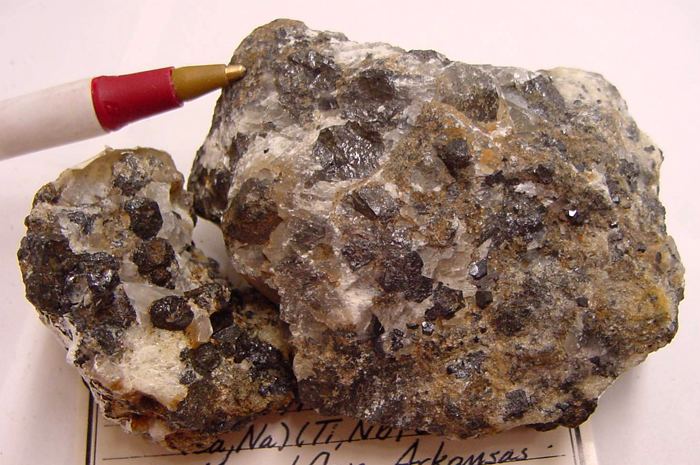Category Oxide minerals Strunz classification 4.CC.30 Space group Pnma | Formula(repeating unit) CaTiO3 Crystal system Orthorhombic | |
 | ||
Crystal class Dipyramidal (mmm)H-M symbol: (2/m 2/m 2/m) | ||
Perovskite (pronunciation: /pəˈrɒvskaɪt/) is a calcium titanium oxide mineral composed of calcium titanate (CaTiO3). The mineral was discovered in the Ural Mountains of Russia by Gustav Rose in 1839 and is named after Russian mineralogist Lev Perovski (1792–1856).
Contents
- Why are there so few perovskite ferroelectrics
- Occurrence
- Special characteristics
- Physical properties
- Layered perovskites
- References
It lends its name to the class of compounds which have the same type of crystal structure as CaTiO3 (XIIA2+VIB4+X2−3) known as the perovskite structure. The perovskite crystal structure was first described by Victor Goldschmidt in 1926, in his work on tolerance factors. The crystal structure was later published in 1945 from X-ray diffraction data on barium titanate by Helen Dick Megaw.
Why are there so few perovskite ferroelectrics
Occurrence
Found in the Earth’s mantle, perovskite’s occurrence at Khibina Massif is restricted to the under-saturated ultramafic rocks and foidolites, due to the instability in a paragenesis with feldspar. Perovskite occurs as small anhedral to subhedral crystals filling interstices between the rock-forming silicates.
Perovskite is found in contact carbonate skarns at Magnet Cove, Arkansas, in altered blocks of limestone ejected from Mount Vesuvius, in chlorite and talc schist in the Urals and Switzerland, and as an accessory mineral in alkaline and mafic igneous rocks, nepheline syenite, melilitite, kimberlites and rare carbonatites. Perovskite is a common mineral in the Ca-Al-rich inclusions found in some chondritic meteorites.
A rare earth-bearing variety, knopite, (Ca,Ce,Na)(Ti,Fe)O3) is found in alkali intrusive rocks in the Kola Peninsula and near Alnö, Sweden. A niobium-bearing variety, dysanalyte, occurs in carbonatite near Schelingen, Kaiserstuhl, Germany.
Special characteristics
The stability of perovskite in igneous rocks is limited by its reaction relation with sphene. In volcanic rocks perovskite and sphene are not found together, the only exception being in an etindite from Cameroon.
Physical properties
Perovskites have a cubic structure with general formula of ABO
3. In this structure, an A-site ion, on the corners of the lattice, is usually an alkaline earth or rare earth element. B site ions, on the center of the lattice, could be 3d, 4d, and 5d transition metal elements. A large number of metallic elements are stable in the perovskite structure, if the tolerance factor t is in the range of 0.75 – 1.0.
where RA, RB and RO are the ionic radii of A and B site elements and oxygen, respectively.
Perovskites have sub-metallic to metallic luster, colorless streak, cube like structure along with imperfect cleavage and brittle tenacity. Colors include black, brown, gray, orange to yellow. Crystals of perovskite appear as cubes, but are pseudocubic and crystallize in the orthorhombic system. Perovskite crystals have been mistaken for galena; however, galena has a better metallic luster, greater density, perfect cleavage and true cubic symmetry.
Layered perovskites
Perovskites may be structured in layers, with the above ABO
3 structure separated by thin sheets of intrusive material. Different forms of intrusions, based on the chemical makeup of the intrusion, are defined as:
2O
2]2+ ion, occurring every n ABO
3 layers, leading to an overall chemical formula of [Bi
2O
2]-A
(n−1)B
2O
7. Their oxide ion-conducting properties were first discovered in the 1970s by Takahashi et al., and they have been used for this purpose ever since.
3 layers, giving the overall formula as M10+
A
(n−1)B
nO
(3n+1)
3 lattice. Ruddlesden−Popper phases have a similar relationship to perovskites in terms of atomic radii of elements with A typically being large (such as La or Sr) with the B ion being much smaller typically a transition metal (such as Mn, Co or Ni).
